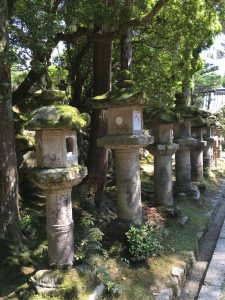Another day away from the city center, just about an hour outside of Kyoto. Formerly Heijokyo, it was established at the end of the Silk Road and was Japan’s first permanent capitol, from 710-784. This time marked the beginning of a strong, centralized state, a catalyst for the growth of a national identity. Buddhism, an import from China and Korea, took root here, flourishing under the patronage of successive sovereigns, including four empresses. There are some of the finest artistic treasures and some of the oldest buildings in the country in Nara, including eight UNESCO World Heritage Sights. The onset of the Nara period in 710 established a time where the capital of the country didn’t move with with succeeding monarch. In Shinto traditions concerning death, when a monarch died, his palaces were considered impure and had to be destroyed and built elsewhere. This was destabilizing to say the least, so it wasn’t until Empress Genmei issued an edict creating a permanent capitol. (Leave it to a woman to figure it out). The capital of Japan moved to Kyoto in 794, and Nara lost some of its importance, and was burned and sacked a few times, but the city managed to recover from these issues and was rebuilt and refurbished.
There are four or five major things to see in Nara: The sacred deer, Todai-ji and the Great Buddha, and Kasuga Taisha, and the five story pagoda. The deer are Sika deer, with hazelnut-brown coats with white spots. Once believed to be messengers of the gods, deer have now been designated National Treasures. The deer have become so accustomed to being fed by visitors that they follow people around. And the best part is that they bow. When you give them one of the treats for sale in the park they literally bow their heads up and down. Just like a Japanese person. Made us all laugh. A couple of them did get a little feisty, giving us a nip when we appeared to walk away after getting done feeding them.
Todai-ji was built to house what was to be the most colossal bronze statue in the world, the Great Buddha of Nara. Daibutsu-den, the Great Buddha hall is the largest wooden building in the world, and the bronze statue of the cosmic Buddha is sitting on a lotus flower in a state of enlightenment. At 50ft tall and 250 tons, it is the largest bronze Buddha in the world. To the left is Nyoirin Kannon, who grants wishes, and to his right, Kokuzo Kannon, symbol of wisdom. All pretty impressive.
Kasuga Taisha lies at the foot of two sacred mountains, once venerated as places chosen b the kami to come to earth. Shaded by Japanese cedars, the shrine buildings lie on the edge of a picturesque primeval forest. The shrine area itself is famous for it’s 3,000 lanterns; moss-covered stone ones line the path and many in bronze hang from in the corridors of the buildings. All are lit only twice a year for specific festivals.
The five story pagoda was built originally in 730, but re-built multiple times, more recently 1426! At 164ft it is the second highest pagoda in Japan, after To-ji in Kyoto.
And then we fed some more deer and spent some time in the visitor center learning how to make an origami deer. Then Karen and I caught a train back to Kyoto, leaving Lizzie and Jonathan to feed more deer and spend the night in the quiet and lovely Nara.
Once back in Kyoto, we spent over an hour waiting to have dinner at a little hole in the wall around the corner from hotel that has been voted the best gyoza in Japan for 2 straight years. It was worth the wait, and quite a fun experience to boot. And we saw two real Geishas walking down the street.
And there are more adventures in Japan to come!


















So I should expect my deer…when?